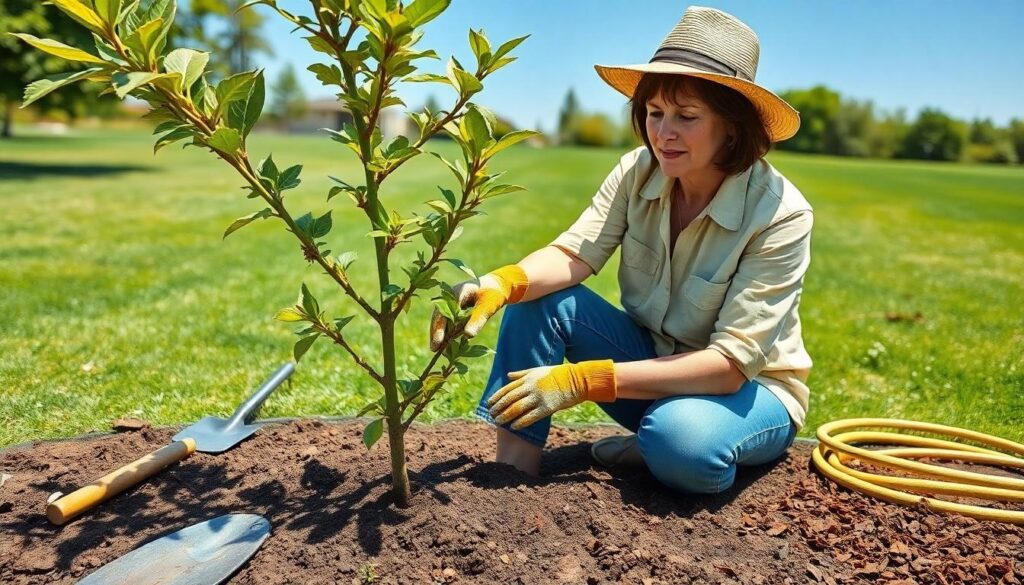Growing fruit trees can be a rewarding experience, but many gardeners unknowingly make critical planting mistakes that doom their trees before they have a chance to thrive. We’ve seen countless enthusiastic gardeners invest time and money into fruit trees only to watch them struggle or die due to simple, avoidable errors.
From improper planting depth to choosing the wrong location, these missteps can severely impact your tree’s health and productivity. The good news? Most of these deadly mistakes are completely preventable with the right knowledge. In this guide, we’ll reveal the most common planting errors killing your fruit trees and show you exactly how to avoid them, ensuring your orchard thrives for years to come.
10 Common Planting Mistakes Killing Your Fruit Trees
1. Planting Too Deep
Planting fruit trees too deep is one of the most common fatal errors gardeners make. The root flare (where the trunk begins to widen at the base) should always remain visible above the soil line. When trees are planted too deeply, the bark below ground level can rot, restricting nutrient flow and eventually killing the tree. Always ensure the graft union stays 2-4 inches above the soil surface for proper development.
2. Choosing the Wrong Location
Many fruit trees fail simply because they’re planted in unsuitable locations. Trees need at least 6-8 hours of direct sunlight daily to produce fruit effectively. Planting in shady areas or too close to buildings not only limits sunlight exposure but also restricts air circulation. Poor air flow increases humidity around your trees, creating perfect conditions for fungal diseases that can devastate your orchard.
3. Improper Soil Preparation
Neglecting proper soil preparation before planting guarantees struggling fruit trees. Fruit trees require well-draining soil with balanced pH levels between 6.0-7.0 for optimal nutrient uptake. Compacted soil prevents root expansion and water absorption, essentially suffocating your trees over time. Testing your soil and amending it with organic matter before planting gives your trees the foundation they need for long-term success.
4. Ignoring Hardiness Zones
Selecting varieties unsuited to your climate is a critical mistake that dooms fruit trees from the start. Each tree has exact chilling hour requirements and cold tolerance limits. Planting a peach variety that needs 700 chilling hours in a region that only provides 400 hours means your tree will never produce properly. Always verify that your chosen varieties are recommended for your exact hardiness zone before purchasing.
5. Insufficient Watering After Planting
Many gardeners underestimate newly planted trees’ water needs during their establishment period. Young fruit trees require consistent moisture while developing their root systems. Inadequate watering during the first growing season creates drought stress that stunts growth and weakens the tree’s overall health. Water deeply at least once weekly, providing 5-10 gallons per tree depending on size and soil conditions.
6. Planting at the Wrong Time
Timing matters tremendously when establishing fruit trees. Planting during extreme weather conditions puts unnecessary stress on young trees when they’re most vulnerable. Late spring plantings often struggle through summer heat before establishing proper root systems. Fall planting (4-6 weeks before first frost) typically provides optimal conditions for most regions, allowing roots to establish before winter dormancy.
7. Neglecting to Remove Competing Vegetation
Allowing grass and weeds to grow around the base of fruit trees creates direct competition for water and nutrients. This competitive stress significantly reduces growth rates and fruit production in young trees. Maintain a weed-free zone extending at least 3 feet from the trunk in all directions, using mulch to suppress competition while conserving moisture.
8. Improper Mulching Techniques
While mulching is beneficial, excessive or incorrect application can harm your trees. The notorious “mulch volcano” (piling mulch against the trunk) creates perfect conditions for bark rot, insect infestation, and rodent damage. Apply mulch in a 3-4 inch layer, keeping it at least 3 inches away from the trunk to create a donut-shaped area that benefits the tree without causing harm.
9. Forgetting to Stake Properly
Incorrect staking damages rather than supports young fruit trees. Staking too tightly restricts natural trunk movement that builds strength, while leaving stakes in place too long creates weak trees dependent on artificial support. When staking is necessary in windy locations, use soft, flexible ties that allow slight movement, and remove all staking materials after one growing season in most cases.
10. Pruning Immediately After Planting
Aggressive pruning right after planting removes valuable energy reserves stored in branches that newly planted trees need for establishment. This premature pruning shock can significantly delay root development and tree growth. Limit first-year pruning to removing only damaged branches and minimal structural shaping, saving major pruning work for after the tree has successfully established itself.
Choosing the Wrong Location for Your Fruit Trees
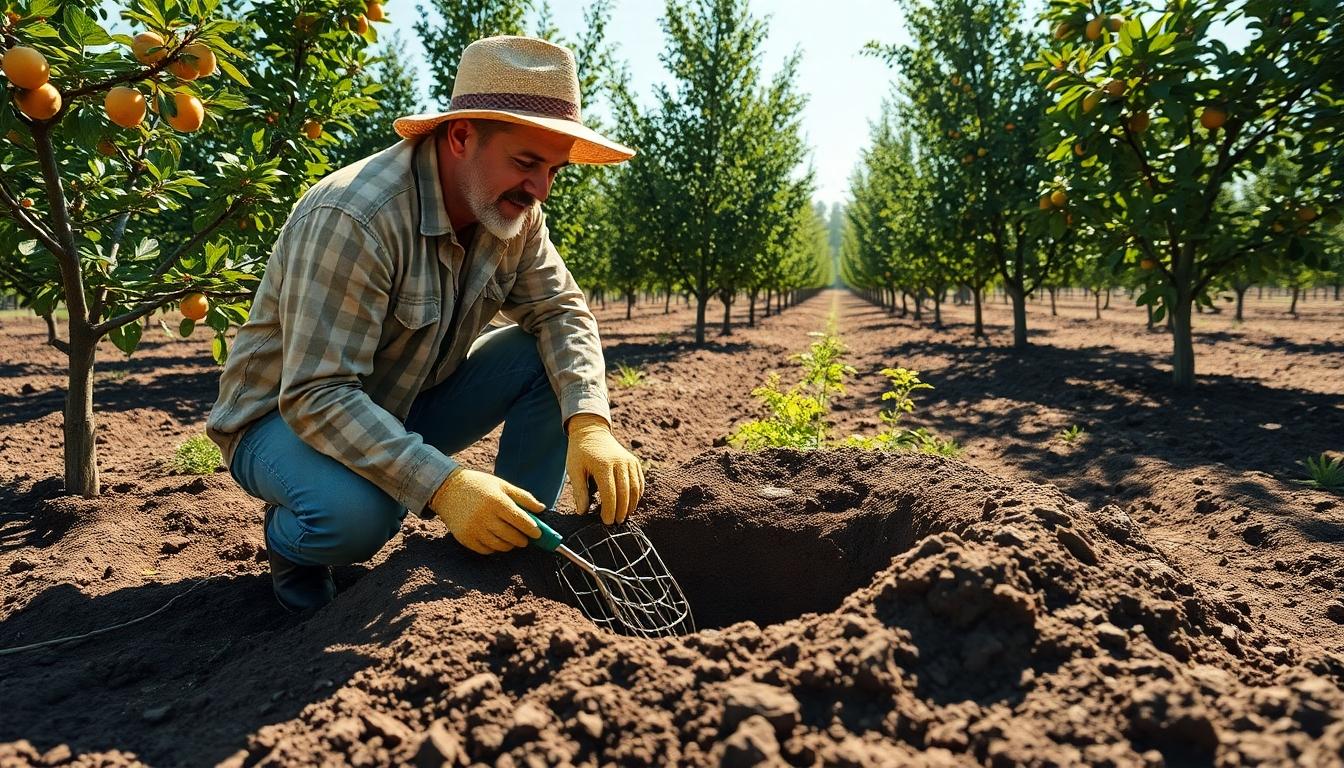
Location is perhaps the most critical factor in determining whether your fruit trees will thrive or struggle. Selecting the wrong spot can doom your trees before they even have a chance to establish themselves.
Ignoring Sunlight Requirements
Most fruit trees require at least 6 hours of direct sunlight daily to produce healthy crops. Insufficient sunlight leads to poor fruiting, weakened growth, and increased vulnerability to diseases. Trees planted in shady areas often develop elongated stems as they stretch toward available light, resulting in structurally weak trees. Always assess your planting site throughout the day to ensure it receives adequate sun exposure before breaking ground. Consider seasonal changes too—a location that’s sunny in winter might be shaded by deciduous trees in summer when your fruit trees need sunlight most.
Overlooking Drainage Needs
Poor drainage is a silent killer of fruit trees, causing root rot and eventual tree death. Water accumulation around roots can suffocate them, as most fruit trees cannot tolerate “wet feet” for extended periods. Ensure your planting site drains water within one to two days after rainfall or irrigation sessions. Clay-heavy soils pose particular challenges for fruit trees due to their tendency to retain water. Before planting, dig a test hole about 12 inches deep and fill it with water; if the water hasn’t drained after 24 hours, you’ll need to improve drainage or select a different location. Well-drained sandy or loam soils provide ideal growing conditions for most fruit varieties, promoting healthy root development and reducing disease pressure.
Planting Trees at the Wrong Depth
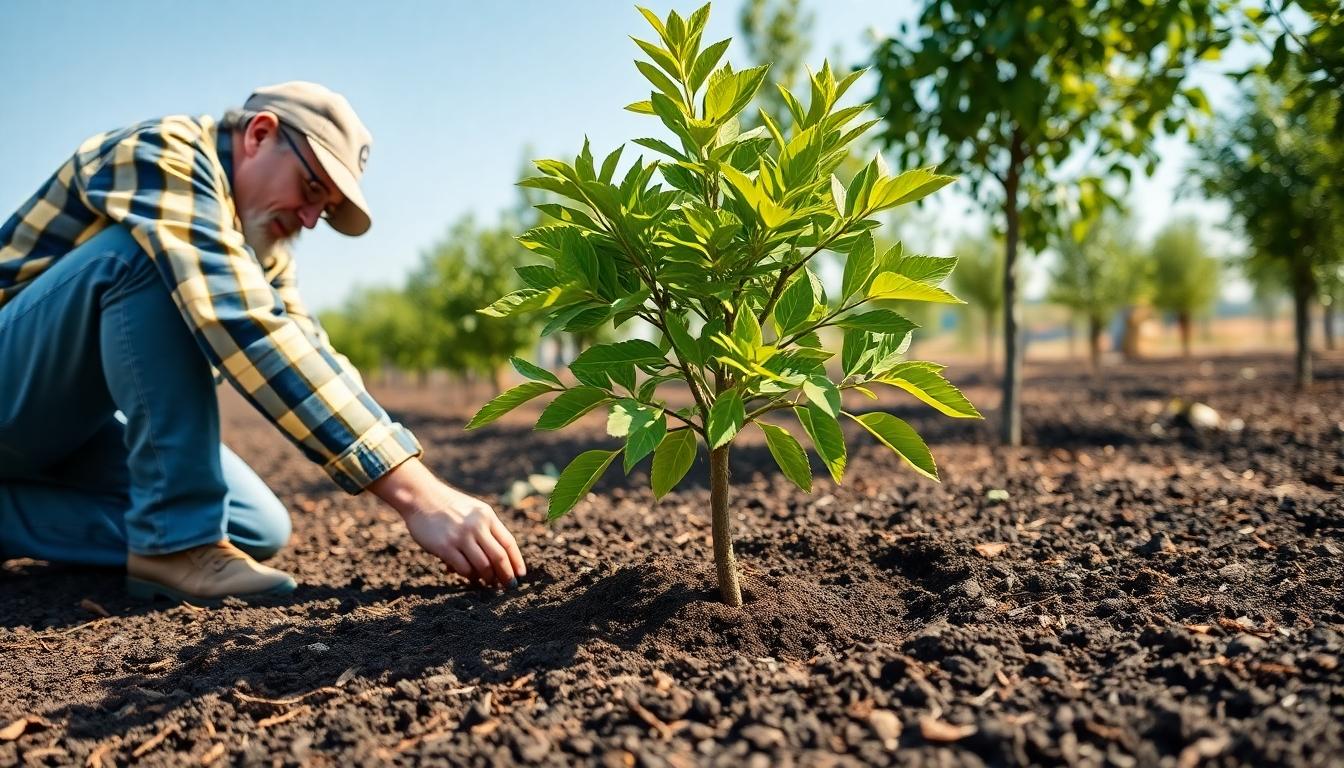
Incorrect planting depth remains one of the most common yet devastating mistakes when establishing fruit trees. Research shows that improper depth is a leading cause of tree failure in the first few years after planting, affecting both immediate health and long-term productivity.
Burying the Root Collar Too Deep
Planting your fruit tree with the root collar buried beneath soil creates ideal conditions for failure. The root collar—that crucial transition zone where the trunk meets the roots—requires oxygen to function properly. When buried, this vital area becomes susceptible to crown rot and dangerous fungal infections that can quickly compromise the entire tree. Studies confirm that trees with buried root collars develop girdling roots that eventually strangle the trunk, cutting off essential nutrient and water flow.
To prevent this fatal mistake, we recommend ensuring the root collar sits 1-2 inches above soil level after planting and settling. This elevated position prevents moisture retention against the bark and allows proper air circulation, significantly reducing the risk of decay. Professional orchardists consistently note that visible root collars produce healthier, more productive fruit trees with longer lifespans.
Setting Trees Too Shallow
Planting fruit trees too high exposes them to unnecessary stress that often proves fatal. Surface-level roots quickly desiccate during dry periods, creating drought conditions even with regular watering. Shallow-planted trees also suffer from poor stability, making them vulnerable to leaning or toppling during wind events or when bearing heavy fruit loads.
Proper planting requires positioning the top roots just below the soil surface—deep enough to ensure moisture retention while avoiding submersion. Agricultural data confirms that properly planted trees establish more quickly and develop robust root systems capable of supporting decades of fruit production. We always recommend digging a hole twice as wide as the root ball but only as deep as needed to position the root collar correctly, then backfilling with loosened native soil to encourage outward root growth.
Tree survival rates increase by up to 60% when planted at the correct depth with proper soil preparation. For best results, ensure your planting site drains well—standing water should dissipate within 1-2 days after heavy rain. Also, applying a 2-4 inch layer of mulch around (but not touching) the trunk helps regulate soil moisture and temperature while suppressing competing vegetation.
Improper Soil Preparation Before Planting
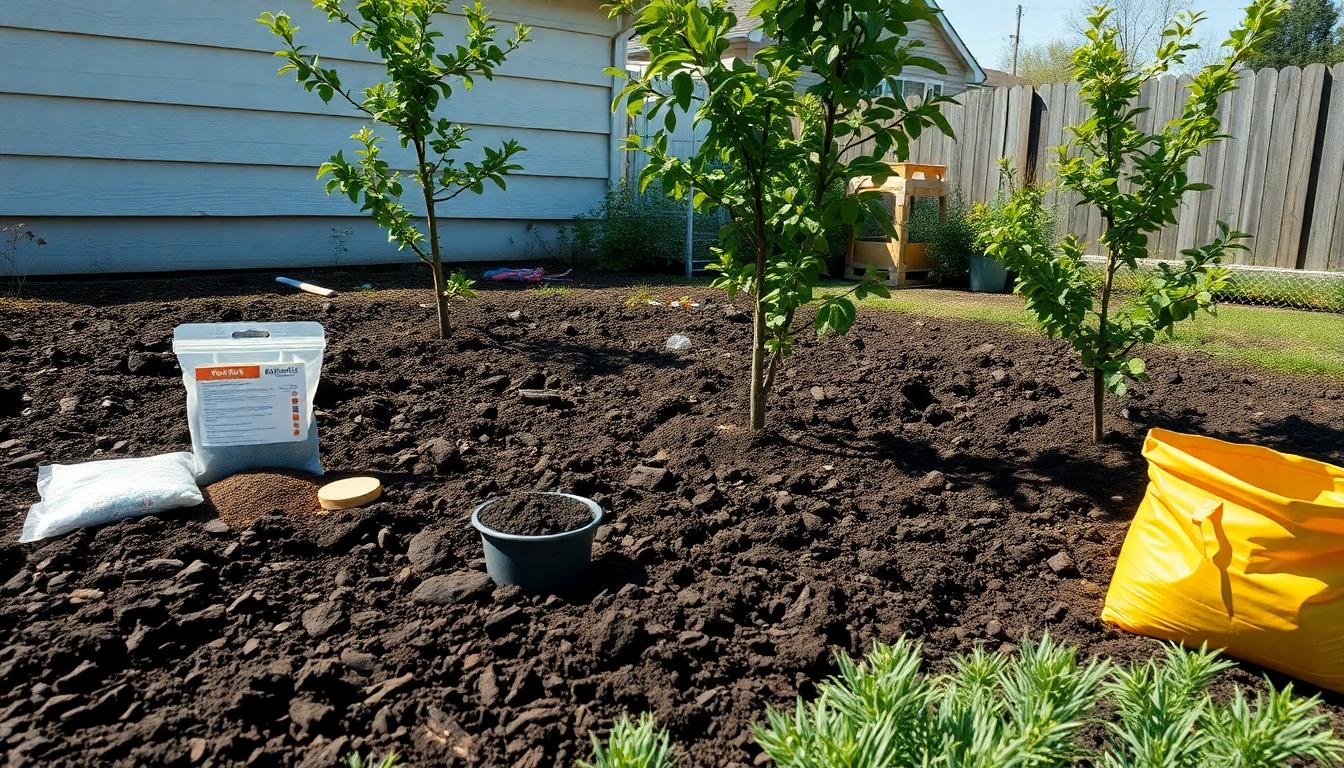
Proper soil preparation is the foundation of a healthy fruit tree. Many gardeners overlook this critical step, setting their trees up for failure before they even begin to grow.
Using Unimproved Native Soil
Using unimproved native soil directly from your yard is a common mistake that can seriously compromise your fruit trees’ health. Native soil often lacks the necessary structure and nutrients that fruit trees need to establish strong root systems. Poor soil conditions lead to stunted growth, reduced fruit production, and increased susceptibility to diseases. Before planting, it’s essential to enhance your soil by incorporating organic matter such as compost or well-rotted manure to improve both structure and fertility. This simple preparation step creates a hospitable environment for young roots to expand and access the nutrients they need. Fruit trees planted in properly amended soil typically show stronger establishment rates and develop more robust root systems that support healthy growth for years to come.
Forgetting to Test Soil pH
Soil pH significantly impacts your fruit trees’ ability to absorb essential nutrients, yet many gardeners skip this crucial testing step. Most fruit trees thrive in slightly acidic to neutral soil with a pH between 6.0 and 7.0, where nutrients are most readily available. Incorrect pH levels can lock up vital nutrients in the soil, making them inaccessible to your trees even though being physically present. Testing your soil before planting allows you to make necessary adjustments with lime to raise pH or sulfur to lower it. Different fruit varieties have exact pH preferences—apples and pears tend to prefer slightly acidic conditions, while cherries often perform better in neutral soils. Investing in a simple soil pH test kit from your local garden center provides valuable information that can prevent years of poor growth and disappointing harvests.
Poor Drainage
Planting fruit trees in poorly draining soil creates conditions that can quickly kill even the healthiest specimens. Waterlogged soil prevents roots from accessing oxygen, leading to root rot and eventual tree death. Fruit trees specifically require well-draining soil to prevent these issues while still retaining enough moisture for proper growth. Before planting, you should always test your soil’s drainage by digging a hole about 12 inches deep, filling it with water, and observing how quickly it drains. Water that takes more than 4-6 hours to drain indicates a potential problem. Adding organic matter, creating raised planting beds, or installing drainage answers can improve conditions in problem areas. Clay-heavy soils particularly benefit from amendments like coarse sand and compost that create air pockets for better drainage while maintaining adequate moisture retention for healthy root development.
Neglecting Proper Tree Spacing
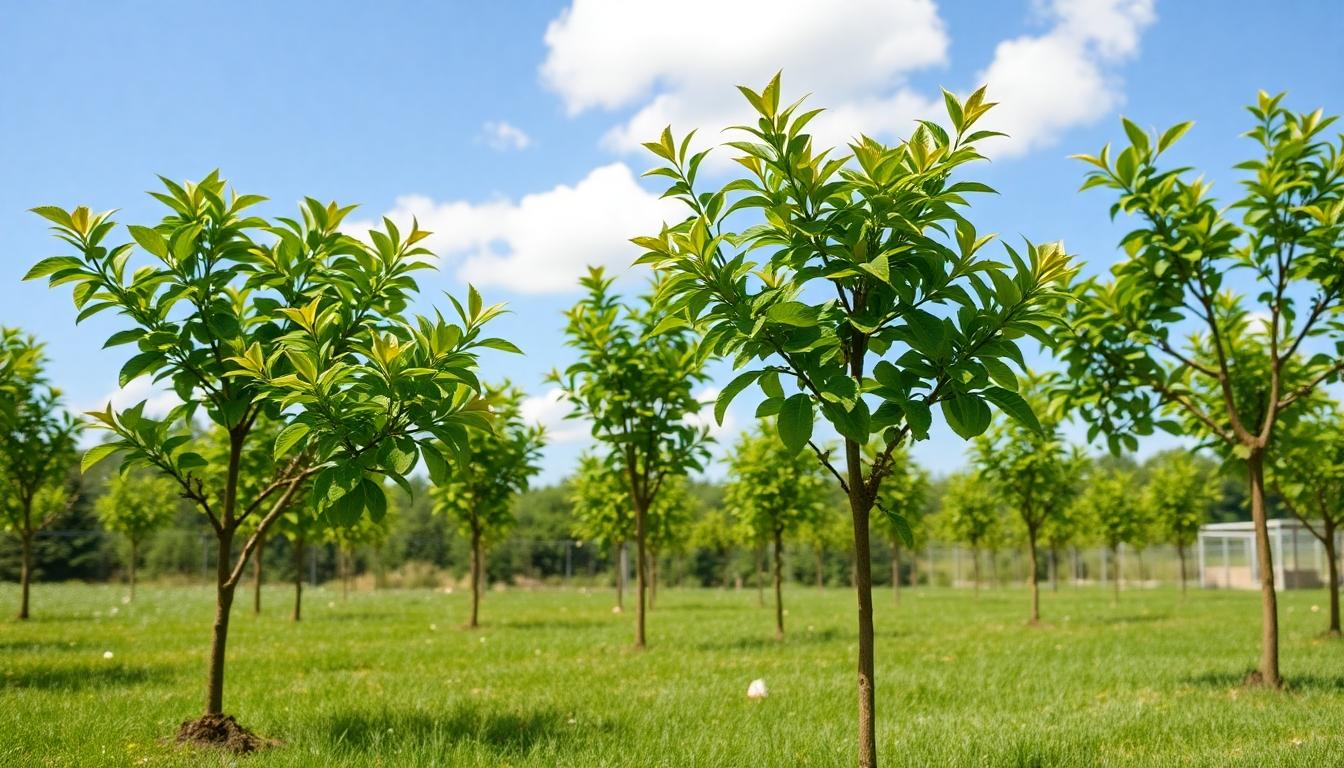
One of the most overlooked aspects of fruit tree planting is providing adequate spacing between trees. We often see gardeners cramming too many trees into limited spaces, which inevitably leads to problems as the trees mature.
Planting Trees Too Close Together
Overcrowded fruit trees compete aggressively for essential resources, creating many problems that can eventually kill your trees. When trees grow too close together, air circulation becomes significantly reduced, creating humid pockets that foster disease development and pest infestations. Trees planted too closely fight for available water and nutrients in the soil, weakening all specimens and reducing their overall vigor. Competition for these limited resources often results in stunted growth and dramatically decreased fruit production over time. For optimal health and productivity, most fruit trees require at least 15 to 20 feet of space between them, allowing their root systems and canopies to develop properly without interference.
Not Considering Mature Size
Many gardeners focus only on the current size of young saplings, failing to account for how large fruit trees will eventually become. As trees grow to their full size, they can shade out neighboring plants or even each other, substantially reducing the sunlight available for photosynthesis and fruit development. This shade competition creates weaker trees that produce less fruit and are more susceptible to disease. Proper planning requires researching the exact varieties you’re planting, as mature sizes vary significantly between different types of fruit trees. Consider both the vertical height and horizontal spread when determining placement, ensuring trees won’t interfere with each other as they reach maturity. Dwarf varieties might need only 10-12 feet of spacing, while standard varieties often require 20-25 feet or more to reach their full potential without crowding issues.
Incorrect Watering Practices After Planting
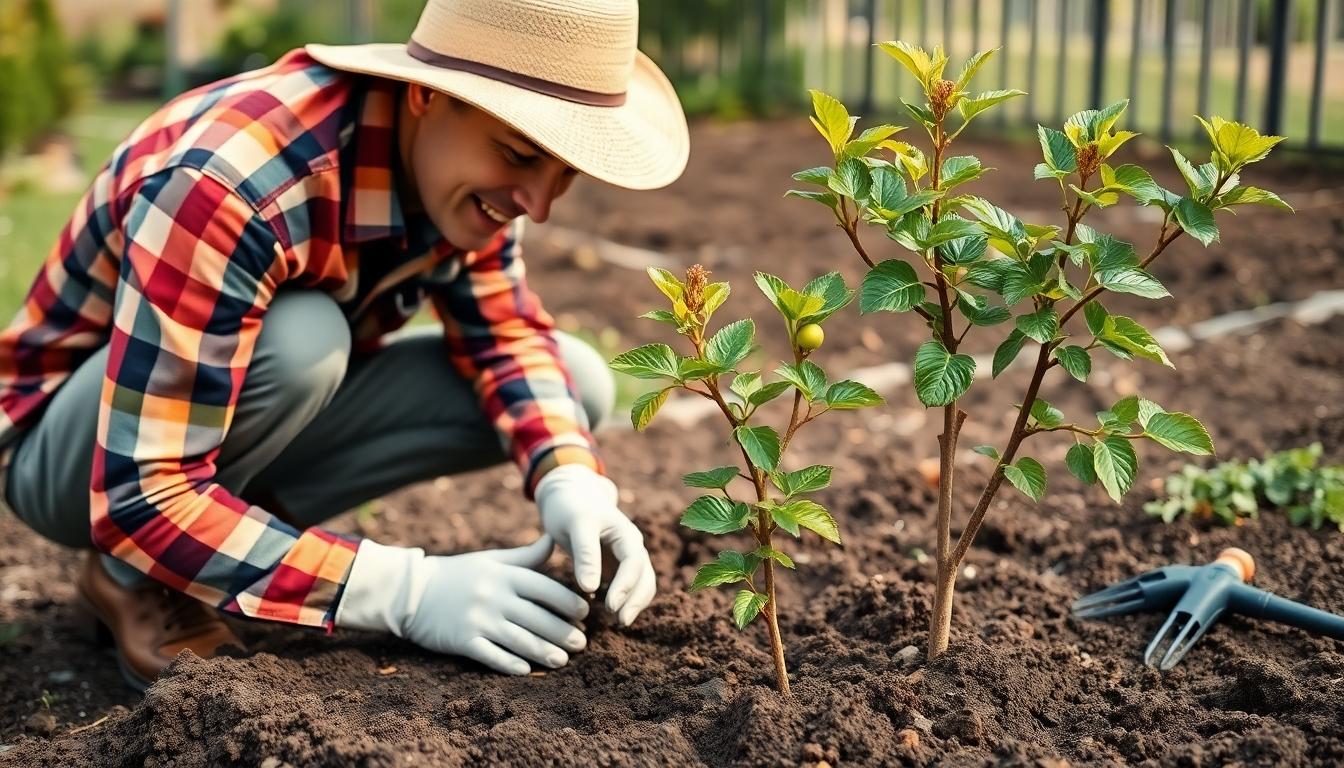
Finding the perfect balance of moisture for newly planted fruit trees is critical for their survival and long-term health. Many gardeners unknowingly harm their trees through improper watering techniques during the establishment phase.
Overwatering Young Fruit Trees
Excessive watering is one of the most common mistakes that can devastate young fruit trees. Saturated soil prevents roots from accessing oxygen, creating an environment where they literally can’t breathe. This oxygen deprivation triggers a chain reaction that weakens the entire tree system. Constantly wet conditions create the perfect breeding ground for fungal pathogens that cause destructive root rot diseases. Signs of overwatering include yellowing leaves, wilting even though wet soil, and darkened, mushy roots when examined. Fruit trees planted in heavy clay soils are particularly susceptible to the dangers of overwatering since these soils naturally retain moisture for extended periods.
Underwatering During Critical Establishment
Insufficient moisture during the first 1-2 years after planting can severely compromise a fruit tree’s future. Inadequate watering during this establishment period prevents proper root development, limiting the tree’s ability to access nutrients and water later in life. Trees suffering from water stress exhibit stunted growth, leaf scorching, and premature leaf drop. The long-term consequences include permanently reduced fruit production capacity and increased vulnerability to pests and diseases. Young trees typically require deep watering 2-3 times weekly during hot, dry periods to develop strong root systems. Newly planted fruit trees have limited root spread, so ensuring moisture reaches the entire root zone consistently is essential for their successful establishment.
Poor Root Management During Planting
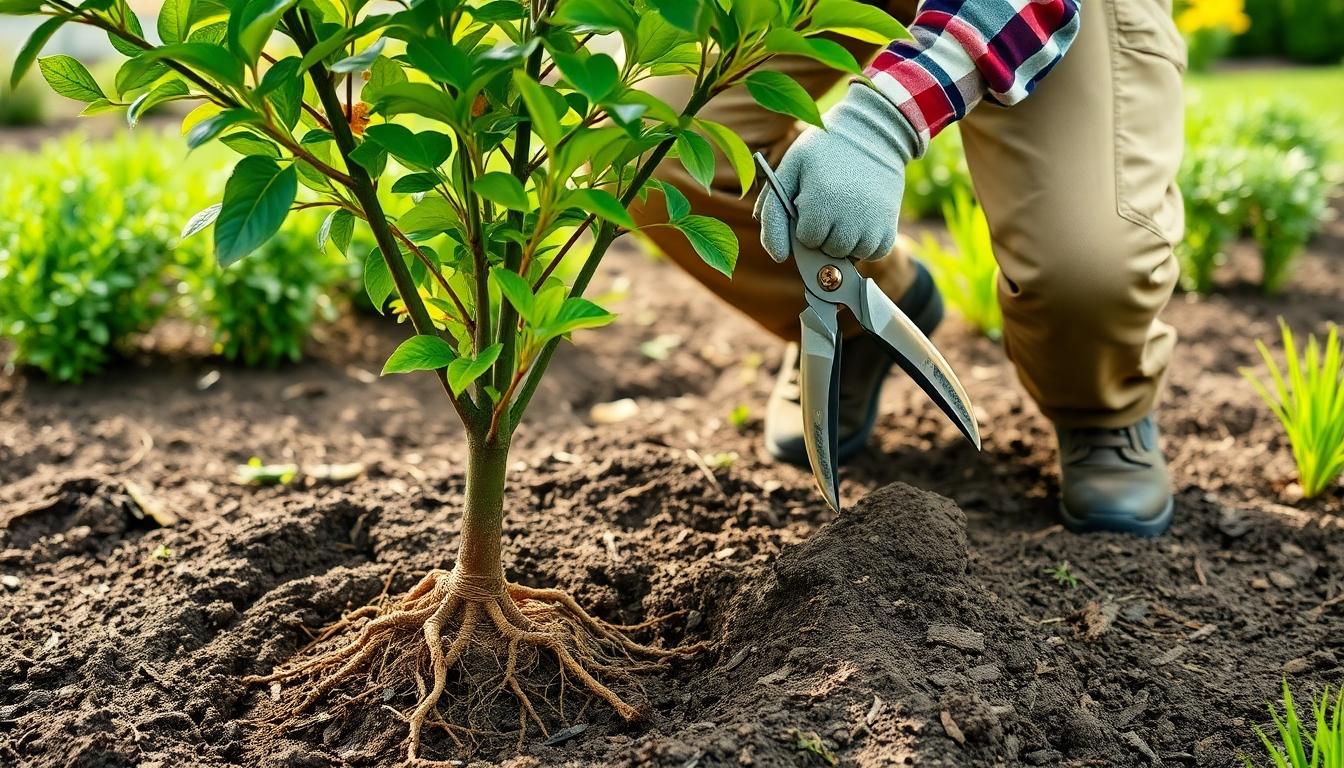
Proper root care during planting is essential for your fruit tree’s long-term health and productivity. Mishandling roots at this critical stage can lead to stunted growth or premature death of your tree.
Failing to Loosen Circling Roots
Circling roots represent one of the most dangerous threats to newly planted fruit trees. When roots grow in a circular pattern around the trunk—common in bare root trees—they can eventually strangle your tree as it matures. This condition, known as girdling, severely restricts water and nutrient uptake throughout the tree’s life. Before planting, we recommend gently teasing apart these circling roots and spreading them outward from the trunk. This simple step encourages roots to grow outward into the surrounding soil rather than continuing their circular pattern. Properly spread roots create a stable foundation for your tree and ensure it can access water and nutrients from a larger soil volume. Trees with corrected root systems establish faster and show greater vigor during their first growing seasons.
Not Removing Damaged Roots
Damaged roots serve as entry points for deadly pathogens that can spread throughout your tree’s root system. Broken, discolored, or mushy roots don’t just fail to support your tree—they actively harm it by harboring diseases. Before planting, carefully inspect the entire root system and use clean, sharp pruners to remove any damaged sections. Cut these roots back to healthy tissue where the interior appears white or cream-colored rather than brown or black. Taking time to prune damaged roots significantly reduces the risk of soil-borne diseases infiltrating your tree’s system. Healthy root systems establish more quickly in new locations and support stronger growth during the critical first year after planting. A thorough root inspection takes just minutes but can prevent years of struggling growth or premature tree death.
Using Harmful Mulching Techniques
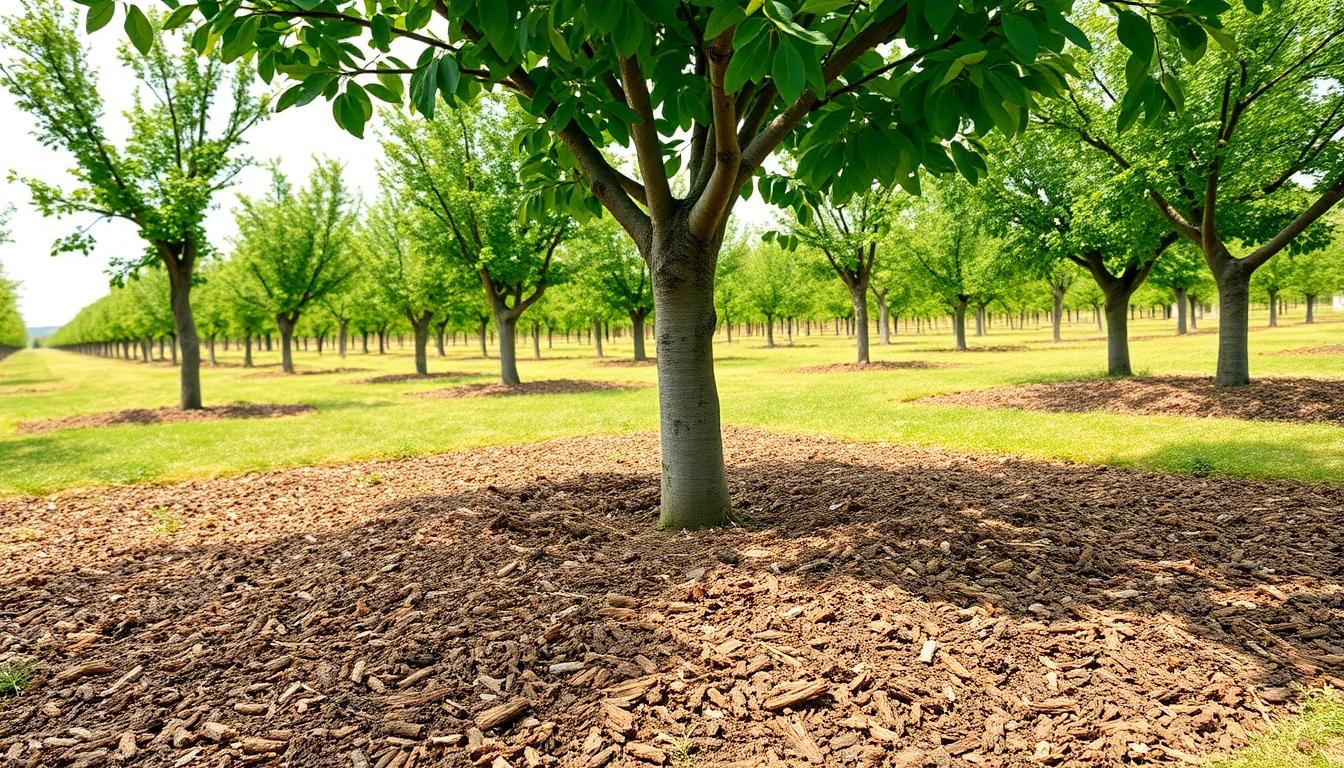
While mulching offers tremendous benefits for fruit trees, improper techniques can actually harm or even kill your precious plants. Let’s examine the most damaging mulching mistakes gardeners commonly make.
Piling Mulch Against the Trunk
Creating mulch volcanoes against your tree trunk is one of the most destructive mulching practices we encounter in orchards. This common mistake traps excessive moisture against the bark, creating the perfect environment for fungal growth and bark decay. Moisture-soaked bark becomes susceptible to diseases that can eventually girdle and kill the entire tree. Professional orchardists always maintain a 3-4 inch gap between mulch and the trunk, allowing proper air circulation and preventing harmful moisture accumulation. Remember to spread mulch in a flat, donut-shaped pattern around the tree instead of piling it high against the trunk.
Using the Wrong Type of Mulch
Selecting inappropriate mulch materials can severely compromise your fruit tree’s health and productivity. Fresh wood chips that haven’t been properly aged can actually steal nitrogen from the soil as they decompose, leaving your trees nutrient-deficient. Grass clippings may seem convenient but often form dense mats that prevent water penetration and create anaerobic conditions harmful to root development. Organic mulches like aged wood chips, straw, or composted bark provide the ideal balance of moisture retention while allowing proper soil aeration. These materials break down gradually, enriching the soil with organic matter and supporting beneficial soil microorganisms that contribute to your tree’s overall health.
Excessive Mulching
Applying mulch too thickly creates more problems than it solves for fruit trees. Overly deep mulch layers exceeding 4 inches can suffocate roots by preventing oxygen exchange and trapping harmful levels of moisture around the root zone. This excessive wetness often leads to root rot, a devastating condition that causes gradual decline and eventual death of the tree. The ideal mulch depth remains between 2-4 inches, providing adequate weed suppression and moisture conservation without compromising root health. We recommend checking mulch depth seasonally and removing excess buildup that may occur as materials settle and decompose over time.
Neglecting Post-Planting Tree Care
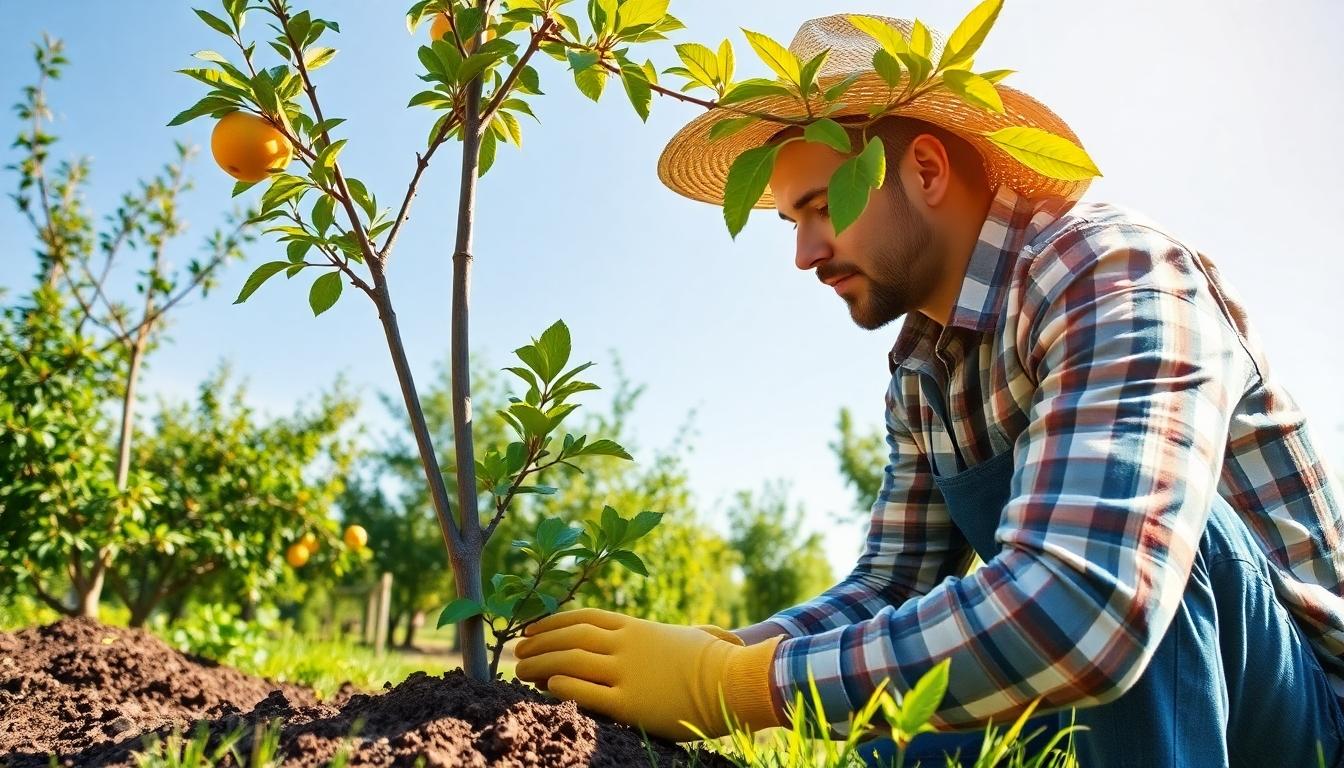
Many gardeners focus intensely on planting day but overlook the critical care needed afterward. Proper post-planting care is essential for establishing healthy fruit trees that will produce abundant harvests for years to come.
Watering Issues
Improper watering is one of the most common post-planting mistakes that can devastate newly planted fruit trees. Insufficient watering causes drought stress, leading to stunted growth and poor establishment during the critical first season. Trees require consistent moisture to develop strong root systems, especially during hot, dry periods when they may need deep watering 2-3 times weekly. Conversely, overwatering creates equally serious problems by promoting root rot and preventing proper oxygen absorption. Soggy soil conditions suffocate roots and create an environment where fungal pathogens thrive, potentially killing young trees before they have a chance to establish. We recommend checking soil moisture by inserting your finger 2-3 inches into the soil near the tree; if it feels dry at that depth, it’s time to water thoroughly.
Soil Conditions
Planting fruit trees in poorly drained soil often leads to their premature death. Waterlogged roots cannot access the oxygen needed for respiration and nutrient uptake, causing them to rot and eventually killing the entire tree. Clay-heavy soils typically present drainage challenges that must be addressed before planting. Testing soil drainage is simple: dig a hole 12 inches deep, fill it with water, and observe how long it takes to drain. Properly draining soil should empty within 24 hours. Adding organic matter like compost or planting on raised mounds can significantly improve drainage in problematic soils. Sandy or loam soils typically provide the best environment for most fruit trees, offering both adequate drainage and moisture retention capabilities.
Skipping Early Pruning
Neglecting pruning after planting prevents fruit trees from developing proper structure and can reduce their productive lifespan. Early pruning establishes the framework for the entire tree, setting up proper branch angles and spacing that will support heavy fruit loads in future years. Many new gardeners avoid pruning young trees because it seems counterintuitive to cut back a plant they’re trying to grow. Training cuts made during the first two growing seasons promote lateral branching and help create an open center that allows sunlight to reach all parts of the tree. Proper pruning also balances the tree’s reduced root system after transplanting with appropriate top growth, reducing transplant shock and encouraging faster establishment. We recommend focusing on removing competing leaders, inward-growing branches, and establishing a strong central leader or open vase structure depending on the fruit variety.
Forgetting to Install Support Stakes
Failing to provide proper support for newly planted fruit trees can result in permanent damage or death, particularly in windy locations. Young trees with undeveloped root systems can easily be shifted by wind, creating air pockets around roots or causing the tree to lean permanently. Support stakes prevent this movement while allowing enough flexibility for the trunk to develop strength naturally. Improperly installed stakes can cause more harm than good if trees are bound too tightly, potentially girdling the trunk as it grows. Most fruit trees benefit from temporary staking for the first 1-2 years after planting, using soft, flexible ties that won’t damage the bark. Stakes should be placed on the windward side of the tree and removed once the tree is firmly established to prevent dependency and encourage proper trunk development.
Timing Your Planting Wrong
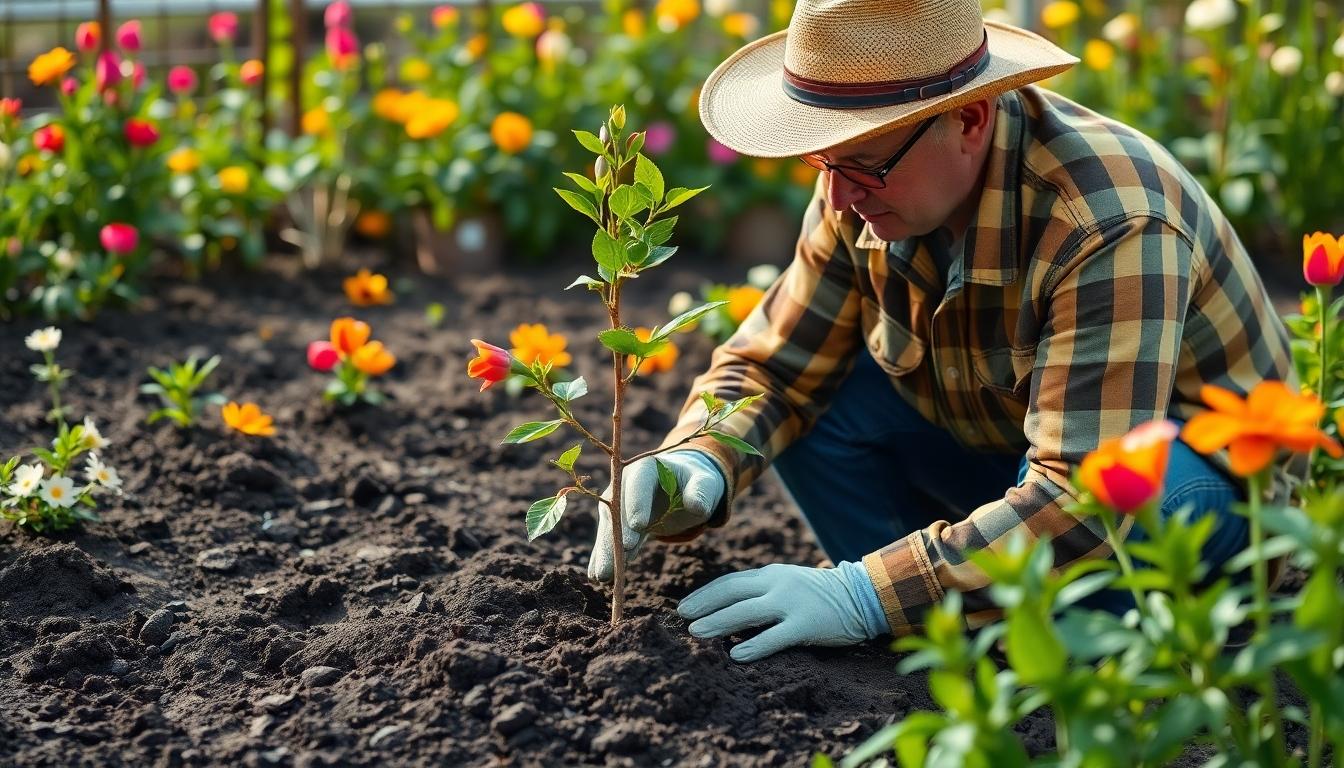
Planting fruit trees at the wrong time of year significantly decreases their chances of survival. Many gardeners overlook the critical importance of timing when establishing new fruit trees.
Planting During Summer Heat
Summer planting puts enormous stress on newly established fruit trees. High temperatures force young trees to divert energy to survival rather than root establishment, creating a dangerous situation for their long-term health. The intense summer heat increases water requirements far beyond what the limited root system can effectively absorb. Research shows that trees planted during hot weather often develop shallow, weak root systems as they struggle to cope with heat stress. Water evaporates quickly from soil during summer months, making it nearly impossible to maintain consistent moisture levels for sensitive new plantings. To avoid these issues, we recommend postponing planting until temperatures moderate in early fall or waiting for the optimal spring window.
Missing the Ideal Seasonal Window
The optimal time to plant fruit trees is during their dormant period in late winter or early spring. Trees transplanted outside these windows experience significantly higher rates of transplant shock and establishment failure. Bare-root trees are particularly vulnerable and require immediate planting when received to prevent their delicate exposed roots from drying out. Professional orchardists consistently achieve higher success rates by adhering to these natural planting cycles that align with tree biology. Early spring planting gives trees a full growing season to establish roots before facing their first winter challenges. Fall planting works well in milder climates where trees can develop roots before winter dormancy, but requires careful timing to avoid early frost damage. By planning your planting schedule around these natural dormancy periods, you’ll dramatically increase your fruit trees’ survival rates and early productivity.
How to Revive Struggling Fruit Trees and Prevent Future Mistakes
Avoiding these common planting mistakes will dramatically increase your chances of growing healthy productive fruit trees. Remember that proper planting depth root management and adequate spacing form the foundation for success.
By giving careful attention to soil preparation watering techniques and seasonal timing you’ll prevent many frustrating problems before they begin. When you notice signs of struggle in existing trees don’t panic – most can be saved with corrective pruning improved drainage or mulching adjustments.
We encourage you to take time planning your orchard beforehand rather than rushing into planting. Your patience will be rewarded with stronger trees better harvests and fewer replacements needed over time. Growing fruit trees is a rewarding journey that gets easier once you understand these critical basics.
Frequently Asked Questions
What is the biggest mistake when planting fruit trees?
Planting too deep is one of the most critical errors. When the root collar is buried, it can lead to crown rot and fungal infections that kill the tree. Always ensure the root collar sits 1-2 inches above soil level and position the top roots just below the surface. This simple adjustment dramatically increases survival rates.
How much sunlight do fruit trees need?
Fruit trees require at least 6 hours of direct sunlight daily for proper growth and fruit production. Inadequate sunlight leads to weak growth, poor fruiting, and increased susceptibility to diseases. Assess your planting site throughout the day, considering seasonal changes in sun patterns to ensure your trees receive sufficient light.
When is the best time to plant fruit trees?
The optimal planting time is during the dormant season in late winter or early spring before bud break. Avoid summer planting, which stresses young trees and impedes root establishment. Fall planting can work in milder climates, giving roots time to establish before winter. Proper timing significantly increases survival rates and early productivity.
How far apart should I plant my fruit trees?
Most fruit trees need 15-20 feet between them to prevent overcrowding. Consider mature sizes: dwarf varieties require 10-12 feet, while standard varieties need 20-25 feet or more. Proper spacing ensures adequate air circulation, reduces disease risk, and prevents competition for water, nutrients, and sunlight, resulting in healthier trees and better harvests.
How do I know if my soil has good drainage?
Test drainage by digging a 12-inch deep hole, filling it with water, and timing how long it takes to drain. If water remains after 24 hours, you have poor drainage. Fruit trees need well-drained soil to prevent root rot. Improve poor drainage by adding organic matter, creating raised planting mounds, or installing drainage solutions.
How should I water newly planted fruit trees?
Newly planted trees typically need deep watering 2-3 times weekly during hot, dry periods. Check soil moisture regularly by inserting your finger 2 inches into the soil—if it feels dry, water deeply. Avoid both overwatering, which causes root rot, and underwatering, which leads to drought stress. Consistent moisture is crucial during the establishment period.
Do I need to stake my fruit trees?
Staking is necessary primarily in windy locations or for trees with weak trunks. Use flexible ties that allow some movement, as this helps develop stronger trunks and root systems. Position stakes outside the root ball and remove them after one growing season once the tree is established. Improper or prolonged staking can weaken trees.
How should I mulch around fruit trees?
Apply organic mulch in a flat, donut-shaped pattern 2-4 inches deep, maintaining a 3-4 inch gap between mulch and trunk. Never create “mulch volcanoes” against the trunk, which trap moisture and cause bark decay. Use aged wood chips, straw, or leaf litter rather than fresh materials that can deplete nitrogen from the soil.
Should I prune my fruit tree right after planting?
Limit initial pruning to removing damaged branches and making minimal training cuts to establish proper structure. Aggressive pruning after planting stresses trees by removing valuable stored energy in the branches. Focus on developing a strong framework by making strategic training cuts during the first two growing seasons.
How do I prepare soil for planting fruit trees?
Enhance native soil with ample organic matter like compost to improve structure and nutrient content. Create a planting hole twice as wide as the root ball but no deeper than the root mass. Test soil pH and adjust if necessary—most fruit trees prefer slightly acidic to neutral soil (6.0-7.0). Proper soil preparation forms the foundation for healthy, productive trees.

